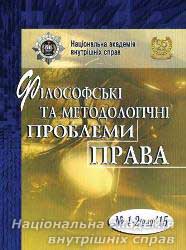Co-Evolutionary Dynamics of Law and Society in Terms of the Method of Mathematical Modeling
Keywords:
ontology of law, social dynamics, co-evolution of law and society, proportionality of legal development
Abstract
On the basis of mathematic modeling means, the conditions of balance between legal development and dynamics of social requirements and opportunities are analyzed. It is proved that he application of such means enables to define some parameters of optimal proportionality of law and society co-evolution. The article demonstrates that although co-evolutionary dynamics of law in the system of social life is a kind of self-organized processes, it still requires a reasonable adjustment in accordance with the principal terms of optimization, especially in terms of dynamic proportionality and balance (because, in addition to their objective factors, these dynamics are significantly dependent on subjective volitional human activity). Even outlined in this article selected examples of such conditions and parameters have to be sufficient reasons for the feasibility of deontological content of law analysis from the point of view of its coordination with ontology of social reality, regulated with this law. In particular, the extension of the range of rights must correspond not only to the increasing scales of subjective needs, but also to the dynamics of the growth of social opportunities for their satisfaction and the effectiveness of mechanisms to ensure the appropriate legal requests; in turn, the content and range of such requests have to be correlated with «already working» practical schemes, and so on. In this relation, the method of mathematical modeling is a quite effective mean of determining and justification of the criteria of social and legal development’s rational proportionality.Downloads
Download data is not yet available.
Abstract views: 134 PDF Downloads: 68
Issue
Section
Methodology of law
Copyright (c) 2017 Philosophical and Methodological Problems of Law

This work is licensed under a Creative Commons Attribution-NonCommercial-NoDerivatives 4.0 International License.
- Authors reserve the right to authorship of their own work and transfer to the magazine the right of the first publication of this work under the terms of the Creative Commons Attribution License, which allows other persons to freely distribute published work with mandatory reference to authors of the original work and the first publication of an article in this magazine.
- Authors have the right to enter into separate additional agreements on non-exclusive dissemination of the work in the form in which it was published in the journal (for example, to post an article in the institution's repository or to publish as part of a monograph), provided that the link to the first publication of the work in this journal is maintained.
- The journal's policy allows and encourages the posting of articles by authors on the Internet (for example, in electronic storehouses of institutions or on personal websites), both before the submission of this manuscript to the editorial office and during its editorial processing, as this contributes to the creation of a productive scientific discussion and positively affects the efficiency and dynamics of citing the published work.




